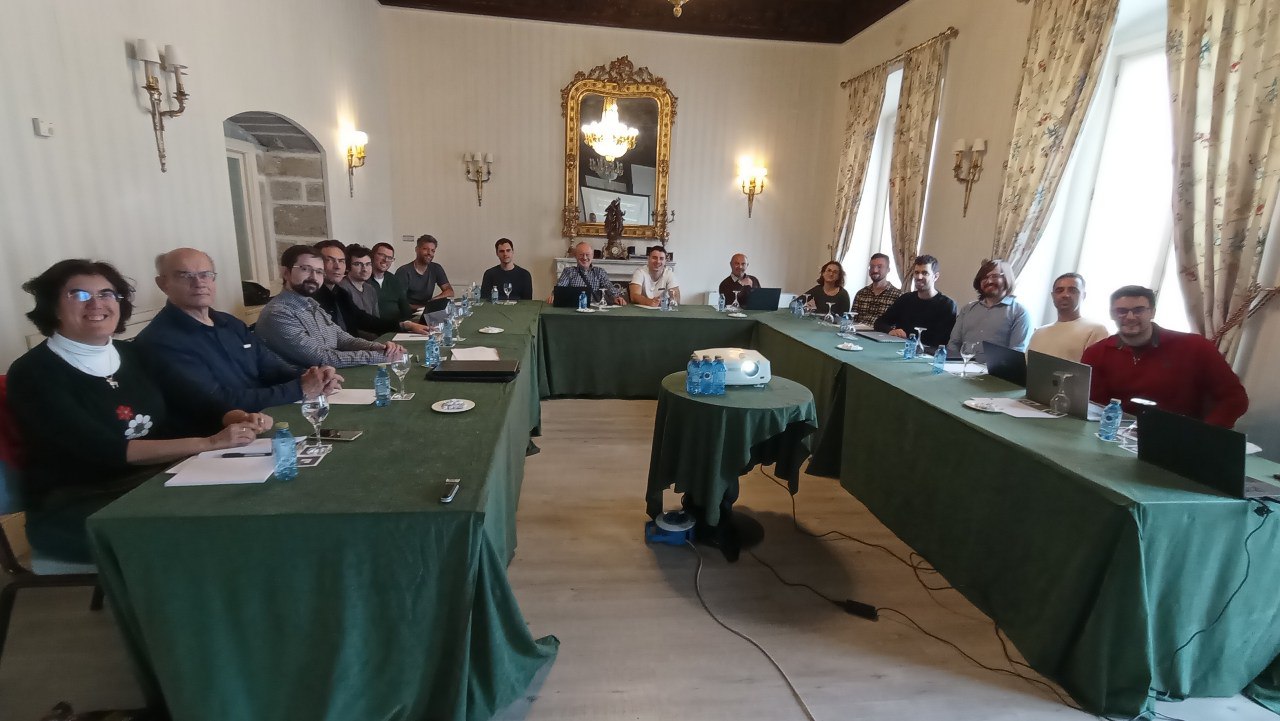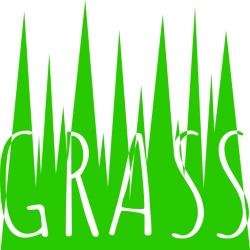Los días 17 y 18 de Noviembre del 2023 se realizó el segundo encuentro entre los miembros de los proyectos coordinados GRASS (IFT, UPV/EHU, U. de Valladolid y U. de la Rioja) y SYMBHOL (U. de Murcia y U. Politécnica de Cartagena), con los Profesores Eric Bergshoeff (U. Groningen, Países Bajos) y Diego Marques (U. de Buenos Aires, Argentina).

La lista de charlas, por orden cronológico es la siguiente (pinchando en el título de la charla o en el nombre del ponent cuando no hay título se descarga la charla):
|
MP García del Moral |
Massive supermembrane, type IIA massive superstring and Romans Supergravity |
In this talk I will explain briefly the relation between a new type of supermembrane, the massive Supermembrane with discrete spectrum formulated in ten non-compact dimensions, its double dimensional reduction: the wordsheet action of a $N=2$ type IIA closed superstring with new couplings and tension that we denote as ‘massive’ superstring; and the 10D Romans Supergravity. |
|
Pablo Saura |
Recently, a new proposal to study anomalous symmetries has appeared: the chiral anomaly can be seen as a special case of generalized symmetry without a group structure, called non-invertible symmetry. This approach allow us to define conserved chages and currents associated with the anomalous symmetry. However, one may ask to what extent can this be called a true symmetry of the system. In this talk I will present the first part of an ongoing work in which we propose the study of entropic quantities to characterize |
|
|
Igor Bandos |
Noether-Wald charge in supergravity, fermions, and Killing supervector in |
The supersymmetry properties of Killing vector in supergravity theory can be clarified by relating that to Killing supervector in the supergravity superspace. The superspace approach makes manifest that supersymemtry ‘mixes’ Killing vector with its fermionic spinor ‘superpartner’ and the Killing equations with the generalization of Killing spinor equations. This later reduces to the standard Killing spinor equation, although for fermionic spinor, when the fermionic field (gravitino) are set to zero. Using these transformations in spacetime, component approach, we construct a Noether-Wald charge of ${\cal N}=1,d=4$ supergravity with fermionic contributions which is diff- Lorentz- and supersymmetry-invariant (up to a total derivative). |
|
Pablo Cano |
I will start by reviewing a few aspects about the linear spectrum of higher-order theories of gravity that contain covariant derivatives of the curvature. I will then study “braneworld gravities”: theories of gravity induced on a brane placed near the boundary of an AdS spacetime that is ruled by Einstein’s equations. It turns out that these theories contain an arbitrary number of covariant derivatives of the curvature. I will show for the first time the exact Lagrangian of these braneworld theories at quadratic order in the curvature, which turns out to have a very peculiar form. Using this result, I will investigate the linearized equations and the degrees of freedom propagated by these theories. Finally, I will focus on the case of 3-dimensional induced gravity, which provides a nonlocal generalization of New Massive Gravity. |
|
|
Pablo Bueno |
The entanglement entropy of an arbitrary spacetime region $A$ in a three-dimensional conformal field theory (CFT) contains a constant universal coefficient, $F(A)$. For general theories, the value of $F(A)$ is minimized when $A$ is a round disk, $F_0$,and in that case it coincides with the Euclidean free energy on the sphere. I will present a new conjecture stating that for general CFTs, the quantity $F(A)/F_0$ is bounded above by the free scalar field result and below by the Maxwell field one. I will provide strong evidence in favor of this claim and argue that an analogous conjecture in the four-dimensional case is equivalent to the Hofman-Maldacena bounds. In three dimensions, our conjecture gives rise to similar bounds on the quotients of various constants characterizing the CFT. In particular, it implies that the quotient of the stress-tensor two-point function coefficient and the sphere free energy satisfies $C_T/F_0 ≤3/(4\pi \log2−6\zeta[3]) \simeq 0.14887$ for general CFTs. I will show that the bound is satisfied by free scalars and fermions, general $O(N)$ and Gross-Neveu models, holographic theories, $N=2$ Wess-Zumino models and general ABJM theories. |
|
|
Giacomo Giorgi |
Scalar fields matter: democratization, applications and type iib |
A democratic formulation of the effective string theory action has been proven to be a powerful tool with applications that range from coupling magnetically branes to flux compactification, among others. While the dualization of higher form fields has already been obtained, it remains the problem of the dualization of scalars even when they are non-linearly realized in the theory. In this work, we develop a systematic method to dualize the scalars coupled to a (p+1)-form potential. As a potentially useful application, we obtain the democratic pseudoaction for N=2B, d=10 supergravity, manifestally invariant under global SL(2,R) transformations. |
|
Eric Bergshoeff |
In this talk I will introduce Carroll fermions, i.e. the fermionic partners of Carroll particles. They will be defined as a special $c \to 0$ limit of (tachyonic) fermions. We will discuss several properties of Carroll fermions such as supersymmetry and the coupling to Carroll gravity. |
|
|
Unai Sarraga |
Hamiltonian mechanics and quantization of simplest 3D counterpart of multiple D0-brane |
Recently we have constructed a completely supersymmetric nonlinear action possessing all the properties expected from a multiple D0-brane system of String theory. Its quantization should result in an interesting supersymmetric field theory in (super)space with non-commuting and non-anti-commuting coordinates, which can provide important insights into the study of String theory. This talk serves as a progress report toward that aim. In it, we construct the Hamiltonian mechanics and discuss the covariant quantization of the simplest three dimensional counterpart of the ten dimensional multiple D0-brane system. |
|
Carlos Shahbazi |
I will give a pedagogical introduction to a natural gauge fixing procedure in Einstein-Yang-Mills theory that can be used to study its configuration space, moduli space of solutions, and partition function. |
|
|
Carmen Gómez-Fayrén |
5-dimensional geometry of 4d static Kaluza-Klein black holes |
In this talk, I’m presenting some of the results we have obtained studying the thermodynamics of the simplest 4-dimensional electrically charged Kaluza-Klein black-hole solutions directly in the 5-dimensional setting. We studied how to uplift the basic 4d elements to 5d, such as the 4d timelike Killing vector and its Killing horizon. The 5d Killing vector we found generates a 5d Killing horizon which is not static. Moreover, demanding the associated 5d vector to be a Killing vector of the 5d metric, the momentum map equation arises, which leads us to the emergence of a gauge-covariant Lie derivative using this KK framework. Finally, an interesting geometric interpretation of the 4-dimensional electrostatic potential is shown. |
|
Diego Marques |
There has been progress in computing some perturbative |
|
|
Luca Romano |
In this talk, we consider heterotic-gravity as the low-energy approximation to heterotic string theory. We define a consistent non-relativistic limit of heterotic gravity that includes the Yang-Mills Chern-Simons term. We perform three tests on the heterotic limit: we use it to (i) derive the non-relativistic transformation rules, (ii) show the existence of a finite non-relativistic heterotic action and (iii) obtain the longitudinal non-relativistic T-duality rules. We show that in all these cases the limit procedure is well defined, free of divergences and leads to consistent non-trivial results. We comment on the interpretation of the T-duality rules in terms of a heterotic |
|
|
J Molina Vilaplana |
Entropic characterization of Non-Invertible symmetries in 2d CFT |
It has been recently realized that the concept of symmetries goes beyond those described by groups. In two dimensions, a symmetry operation can be represented by a topological defect line across which the operation is performed. The action of the topological operator must not be necessarily invertible, and one may regard the algebraic structure formed by the totality of topological defect lines as a generalized version of symmetry. In this talk, that would be considered a complement to Pablo Saura’s talk, I will communicate on an ongoing work focused on using entropic quantities such as the relative entropy in order to characterize the presence of these non-invertible symmetries in 2D CFT. |

